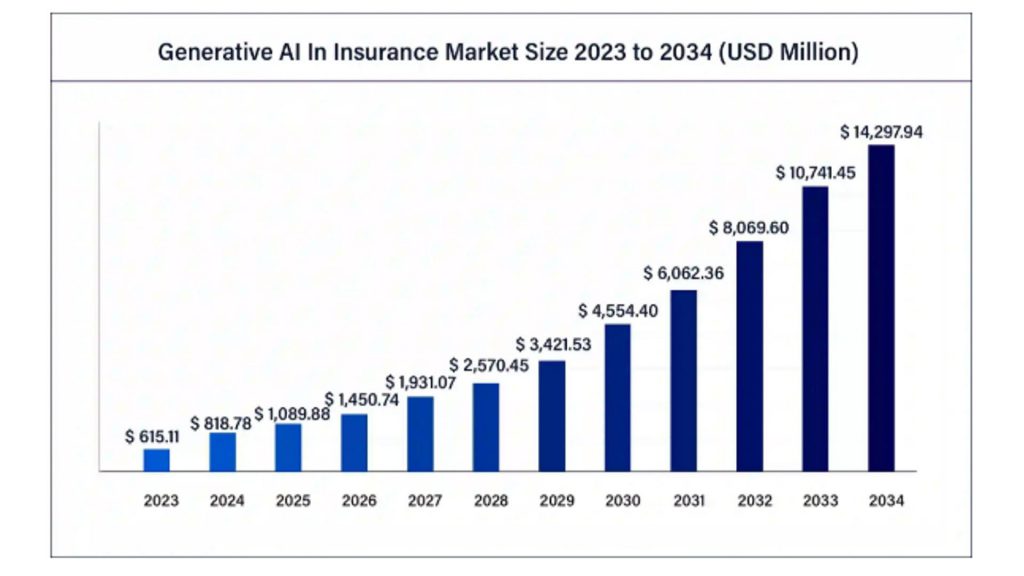In the landscape of insurance technology, the integration of generative AI is proving to be a game-changer in automating claims processing. The global generative AI in insurance market has witnessed significant growth, with an estimated value of USD 818.78 million in 2024. This market is poised to experience substantial expansion, with a projected worth of approximately USD 14,297.94 million by 2034. Notably, the compound annual growth rate (CAGR) for this period is anticipated to be 33.1%, indicating a robust and accelerating adoption of generative AI in the insurance sector.

Generative AI has the potential to completely transform the sales and distribution phase of the insurance value chain by applying state-of-the-art AI algorithms that are already available. This blog explores how generative AI is revolutionizing the industry by enhancing efficiency and accuracy.
1. Claim Processing
Automating claims processing has long been a challenge for the insurance industry. Insurance underwriting and other major responsibilities in the insurance field used to primarily rely on staff to analyze previous data and draw informed judgments. The need to swiftly and accurately assess damages, estimate repair costs, and expedite claims approval has fueled the exploration of innovative solutions with generative AI in insurance industry.
2. Fraud detection
One of the critical challenges in the insurance industry has been combating fraud. Generative AI plays a pivotal role in fraud detection by scrutinizing vast datasets for anomalies and patterns indicative of fraudulent activities. Its ability to process complex data sets allows for real-time detection, mitigating the financial impact of fraudulent claims on insurance companies.
3. Accelerated claims processing
Generative AI, with its ability to understand and process complex data, has emerged as a powerful tool in automating claims processing. In a typical scenario, generative AI utilizes advanced algorithms, such as Convolutional Neural Networks (CNN), to analyze vast datasets of images.
ValueLabs built an AI platform for the client in claims processing centers around a sophisticated CNN model. Trained on a dataset of 200,000 vehicle images manually classified into distinct categories, the model achieved remarkable accuracy in identifying damaged panels – over 90% accuracy in image classification and 85% accuracy in categorizing repair types.
4. Customer experience enhancement
Generative AI-powered virtual assistants provide real-time support to customers, addressing policy inquiries, claims status updates, and general insurance-related questions. Virtual assistants enhance customer interactions and reduce the burden on customer support teams. By leveraging our generative AI-powered conversational chat agent, AiDE Chat, our client in healthcare industry transformed its customer experience with 24×7 support and accurate responses to insurance queries.
5. Automated underwriting
Underwriting, a core function in the insurance sector, involves assessing risks and determining coverage. Generative AI simplifies and optimizes underwriting procedures by analyzing vast amounts of data to generate precise and unbiased insurance plans. This not only accelerates the decision-making process but also boosts the productivity of operators.
6. Predictive analytics
Generative AI’s predictive analytics capabilities are a game-changer for the insurance industry. By leveraging historical data and identifying patterns, it enables insurers to anticipate future trends and risks accurately. This proactive approach empowers insurance companies to make informed decisions, preventing potential losses and optimizing resource allocation.
Conclusion
While the above use cases talk about the general application of GenAI, it is important we remember that things work in tandem and it’s essential to not just deploy ‘pilots’ and instead do a complete ‘overhaul’.
Reimagining domains is key because isolated use cases often come with restrictions due to dependencies on other systems and processes. At this pivotal moment in generative AI, it’s essential to take a step back and rethink claims, underwriting, and distribution. Combining these technologies and designing processes to capture the right data at the right points can drive meaningful change. However, achieving this transformation requires not only technological investments but also significant commitment and adaptability. The ongoing shift toward digitization in insurance distribution presents a wealth of opportunities where both insurers and policyholders benefit from smarter, more efficient systems.
The generative AI revolution is not just a possibility; it’s a reality that is reshaping the insurance tech sector for a brighter and more intelligent future.